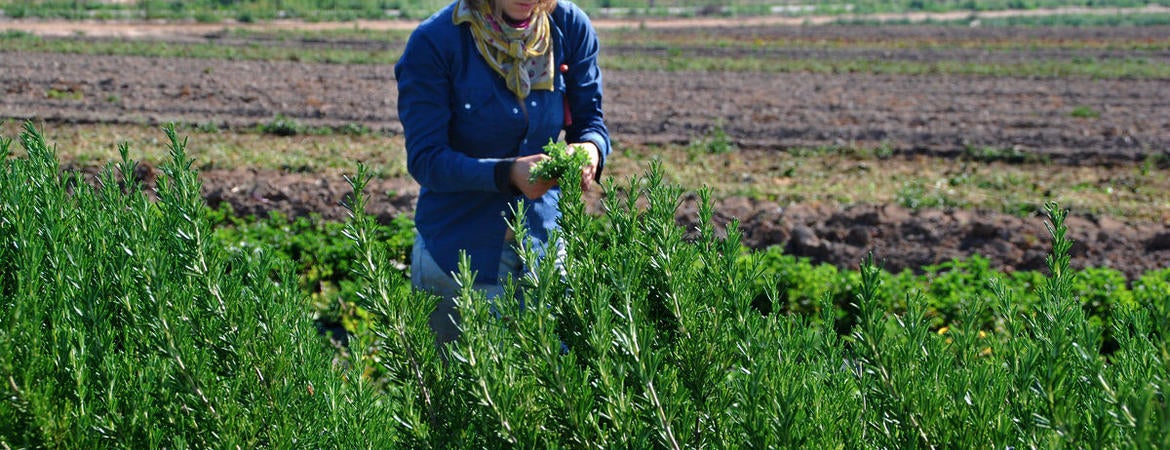Office of Sustainability

Climate Solutions: Harnessing the Power of Local Agriculture
Speaker: Puja Batra, PhD
UC-Riverside - Planetary Health Center
- Research about the intersection between climate solution and agriculture
- Works for San Diego County
- Ecologist; Solves problems on sustainability
- Academic background in ecology and evolutionary biology
- Began doing research in honey in India
- Environmental conservation and eco-diversity
- Economics of communities and making the research
- Sustainable in water availability
- Functioning systems recreating native systems; eco-systems
Terminology
- Organic Agriculture: focus on agro-ecological system as a whole. Specific metrics, methods. Heavy emphasis is on soil health.
- Sustainable Agriculture:Considers integration of people/planet/profit. No fixed netrics, emphases vary within context.
- Regenerative Agriculture: focus on restoring ecological health involving biodiversity and soil health
- Climate-Smart Agriculture: focus on climate risks
- Carbon Farming: focus on carbon sequestration on soil and vegetation
- Some research is pointing to micro activity
- Gas flux will tell you the gas reduction
Tackling Climate Change has 2 Parts:
Mitigation: Slowing down climate change by reducing its causes
Resilience: Maintaining key processes and bouncing back in the face of climate challenges
Climate-smart agriculture can help us do both!
- Climate change challenges for agriculture can lead to even greater GHG emissions
- Increasing cost of farming
- Point of intervention is the soil
The Multiple Benefits of Carbon Farming
- On one hand: Excessive carbon pollution in the atmosphere is causing climate change.
- On the other hand: Carbon is the substance that all living things are made of.
- Figuring out the economics of making it viable to boost farmers’ livelihoods
Soil as Natural Climate
- 4 per 1000 Initiative launched in 2015
- Sustainable Development Goals
- Goal 2: Zero hunger
- Goal 13: Climate action
- Goal 15: Life on hand
- California
- Policies aimed at rescuing landfilling of organic waste
- Rangeland compost
- Other states: NY, HI, MD, UT, OK, MA
- Healthy soils grant is based on the tools that are provided and will be trusted
- Reducing landfill reducing methane
- Look at various aspects of vegetation and soil
- Better in the long run
Mitigation Benefits of Carbon Farming
Carbon farming practices reduces levels of GHGs in the atmosphere. They do this in 3 ways…
- They reduce activities that cause GHG emission such as tillin, or using synthetic fertilizer
- They help plants grow, which locks in, or sequesters carbon for the lifetime of the plant
- They sequester carbon in the soil in forms such as ________
- Grasslands will be better for carbon sequestering
- Up to 40% of the carbohydrates can leak through the roots
- Clumps of nonliving mineral…
- The sponge structure is what helps it hold it
- The fungi and bacteria helps acquire nutrients
Emerging Theories on Soil Consumption
- Carbon is binding to the soil particle
- Clay holds more carbon; the bigger particle
- The surface area for binding the organic material
Resilience Benefits of Carbon Farming
- Carbon farming can increase the resilience of a farming landscape
- When you hold more water in the ground, the runoff is decreased.
- Water quality benefit and groundwater benefits
- Compost gives us an avenue to a way linked to …
WHY AREN’T WE DOING THIS ALREADY?
Vision: San Diego County’s agricultural community is a key partner in developing a resilient, climate-friendly region
San Diego County has more small farms and certified organic farms than any other county in the US
- The average age of a San Diego County farmer is 62 years old. Younger farmers are largely … first-time farmers
- Highlight “ecosystem services” relationship between San Diego COunty and San Diego agriculture
- Identify synergies that could help
- How much net GHG reduction can be achieved through carbon farming in San Diego County?
- What state and local policy synergies exist that are compatible with the gals of carbon farming? What funding mechanisms exists for conversion to carbon farming? What financial incentives?
- Removal of 25% of orchard acreage has resulted in the loss of over 300,000 MTCO2e in the last decade
- The increasing cost of farming
- Nurseries have high transportation cost in San diego
- Food production is decreasing; Framers are holding on to their farms but they are not contributing to food security
Recommendations
- Conserve the existing agricultural carbon storage and sequestration by addressing root drivers behind the…
- Compost applications on slope-amenable
Multiple Resilience Challenges
Stormwater flow
Habitat
Agricultural water quality
Manure management
GHG mitigation
The Future of Farming: Barriers to Eating
WHO’S GOING TO DO IT?
- Land access
- Credit and capital
- Business
- Water
- Training
- Cumbersome processes for government assistance programs
- Seize the opportunity for climate irrigation
Implementation of Strategies
- Carbon Framing Task Force
- Challenges: Root Causes: Water pricing
- Mtiation vs. Resilience Trade-Offs
- Resilience for who?
- Climate resilience strategies - perennials
- Economic resilience strategies - annuals, ornamentals
- Water districts unable to make money
- Slow down the loss of our climate-friendly orchards by addressing root causes
- Create incentives that recognize the climate services provided by farmers
- Challenges: Compost value chain - regulatory hurdles
- Offsets - transactions cost, social justice objections, and real reductions
- Mitigation fund - perverse incentive
- Metrics for payment for ecological services
- Challenges: Compost value chain - regulatory hurdles
Ease major barriers and enable the new generation of farmers and ranchers to succeed at building a climate-sustainable agriculture
- Challenges:
- Property Values
- Leasing vs. Owning
- Local technical support availability
- Certification vs. Mainstream
WATER CANNOT BE PRICED DIFFERENTLY